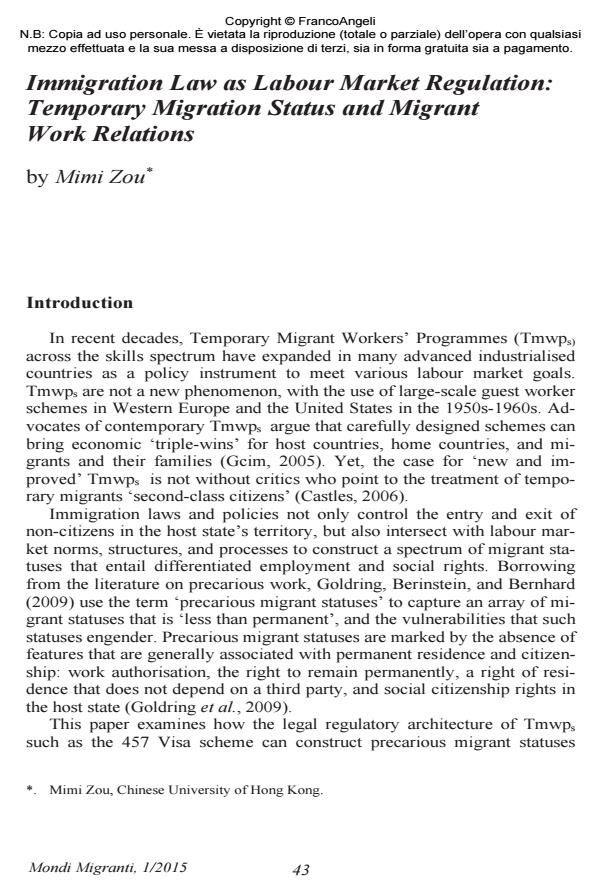Immigration Law as Labour Market Regulation: Temporary Migration Status and Migrant Work Relations
Journal title MONDI MIGRANTI
Author/s Mimi Zou
Publishing Year 2015 Issue 2015/1
Language English Pages 22 P. 43-64 File size 75 KB
DOI 10.3280/MM2015-001003
DOI is like a bar code for intellectual property: to have more infomation
click here
Below, you can see the article first page
If you want to buy this article in PDF format, you can do it, following the instructions to buy download credits

FrancoAngeli is member of Publishers International Linking Association, Inc (PILA), a not-for-profit association which run the CrossRef service enabling links to and from online scholarly content.
This paper examines the way in which immigration law function as a form of labour market regulation, which directly structure and shape the employment relations of migrants in advanced industrialised countries. In particular, Temporary Migrant Workers Programmes (Tmwps) have rapidly expanded in recent years and have been actively promoted by national and global policy makers as a desirable labour migration instrument for host states, home states, and migrants themselves. Through analysing the regulatory design and operation of a contemporary Tmwp - Australia's Subclass 457 Visa scheme - this paper seeks to develop a conceptual framework to elucidate the legal production of ‘precarious migration status’ and its role in shaping certain vulnerabilities in migrant work relations. These vulnerabilities are coined 'hyper-dependence’ and ‘hyper-precarity’. Hyper-dependence refers to a migrant worker’s extreme dependence on and subordination to her sponsor/employer for the legal authorisation to work and reside in the host state. It is concerned with a high degree of labour unfreedom inherent in the ‘tie-in’ structure of Tmwps, where there are de jure and de facto restrictions on migrant workers to change employers, occupations, sectors, and workplaces. The notion of hyper-precarity refers to the tenuous nature of these migrants' job security, employment and social protections that arise from their precarious statuses under Tmwps.
Keywords: Immigration Law; Temporary Migrant Workers Programmes (Tmwp);; Australia's Subclass 457 Visa scheme, Hyper-dependence; Hyper-precarity.
- Patchy progress? Two decades of research on precariousness and precarious work in Australia Iain Campbell, John Burgess, in Labour & Industry: a journal of the social and economic relations of work /2018 pp.48
DOI: 10.1080/10301763.2018.1427424
Mimi Zou, Immigration Law as Labour Market Regulation: Temporary Migration Status and Migrant Work Relations in "MONDI MIGRANTI" 1/2015, pp 43-64, DOI: 10.3280/MM2015-001003